Please report any broken links or trouble you might come across to the Webmaster.
Please take a moment to let us know so that we can correct any problems and make your visit as enjoyable and as informative as possible.
| Click On Image For Full Size | Size | Image Description | Source | |
|---|---|---|---|---|
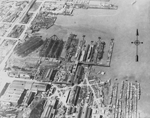 0814300 |
7.80k | Union Iron Works, San Francisco, California. Photographed during World War I, with four-piper destroyers under construction at the Risdon Iron Works in the lower right. Four submarines and one destroyer hull in dry-dock are at the piers in the center, along with some large merchant ships. Risdon, part of Union, is to the lower right of the ink line. 1-Cafeteria, 2-Store room, 3-Iron Foundry, 4-Brass Foundry, 5-Machine shop, 6-Pattern shop, 7-Erecting machine shop, 8-Administration building, 9-Power house, 10-office bldg., Govt. offices, 11-Blacksmith shop, 12-Bioler shop, 13-Joiner shop, 14-Joiner shop, Annex with oil storage tanks underneath, 15-Warehouse and office bldg., 16-Pipe and copper shop, 17-Steel storage, 18-Plate shop, 19-Gate house, 20-Building slips 4&5, 21-Building slips 1.2 & 3, 22-Wharf #2, 23-Wharf #3, 24-Floating dock, capacity 2000 tons, 25-Floating dock, capacity 6500 tons, 26-Wharf #4, 27-Wharf #5, S-Storage space 2--Risdon Plant shown south and east of red lines: 1-Copper storage, 2- Oil tank, 3-Office building, 4-Office building, 5-Yarrow boiler shop, 6-Warehouse, 7-Power house, 8-Blacksmith shop, 9-Storehouse, 10-Sheet metal shop, 11-Sheet metal shop, 12-Marine machine shop, 13-Wharves, 14-Wharves, 15-Wharves. Appearing here in no order are vessels that were constructed but not necessarily here: 6 of 27 R-class submarines first keel laid: R-16 (SS-93), 26 April 1917, last: R-19 (SS-96), 23 June 1917 first launch: R-15 (SS-92), 10 December 1917, last: R-19, 28 January 1918 R-15 (SS-92) ... R-20 (SS-97) 12 of 51 S-class submarines S-30 (SS-135) ... S-41 (SS-146) 26 of 111 Wickes-class destroyers for the United States Navy between 1917 and 1919 first keel laid: Ringold (DD-89), 20 October 1917, last: Stansbury (DD-180), 9 December 1918 first launch: McKee (DD-87), 23 March 1918, last: Stansbury, 16 May 1919, 8 are launched on 4 July 1918 McKee (DD-87) ... Gridley (DD-92), Schley (DD-103), ... Ludlow (DD-112), Burns (DD-171) & ... Stansbury (DD-180) 40 of 156 Clemson-class destroyers for the United States Navy between 1918 and 1921 Chauncey (DD-296) ... Melvin (DD-335) |
Photo courtesy of history.navy.mil | |
 |
1.79k | Construction of Uncle Sam's latest type of Submarine Class R, 6 March 1918. Six R boats under constructions at Union Iron Works, San Francisco, CA. R-15 (SS-92), R-16 (SS-93), R-17 (SS-94), R-18 (SS-95), R-19 (SS-96) & R-20 (SS-97). The three boats closest to the camera are numbered on their sterns 16, 17 & 18. The other three boats viewed bow on can't be identified. |
National Archives Identifier: 55173460 Local Identifier: 111-SC-006278. Photo courtesy of catalog.archives.gov | |
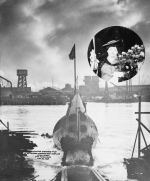 | 608k | R-20 (SS-97), launched at Bethlehem Shipbuilding Corp. Lt'd, Union Plant San Francisco on 21 January 1918. The left insert is a picture of the ship's sponsor, Mrs. Arnold Foster. | USN photo courtesy of Darryl L. Baker. | |
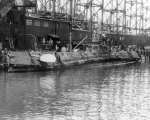 | 97k | R-20 (SS-97) taken in 1918, probably at the Bethlehem Shipbuilding Corp. Lt'd, Union Plant San Francisco. | USN photo . | |
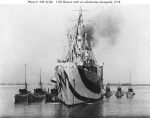 | 87k | Beaver (AS-5) at anchor off the Mare Island Navy Yard, California, with six submarines alongside, circa late 1918. R-17 (SS-94), R-20 (SS-97), R-15 (SS-92), R-16 (SS-93), R-18 (SS-95) & R-19 (SS-96). | USNHC photograph # NH 56366. | |
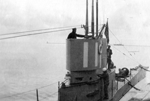 |
1.38k | 3 page PDF of the R-20 (SS-97) in San Pedro ca 1919. The Los Angeles Lighthouse in the background to the far left. I think Beaver (AS-5) is in the background to the right of R-20's fairwater/Conning tower/sail. |
Text via Ric Hednan. Photos from the files of the Vallejo Naval & Historical Museum via Darryl L. Baker. |
|
 |
731k | R-20 (SS-97) and her sisters (R-15 (SS-92), R-16 (SS-93), R-17 (SS-94), R-18 (SS-95) & R-19 (SS-96)) are seen in Mare Island's dry dock #2 between 7 April and 10 June 1919. The barge is YR-2. The submarines were in overhaul at the yard from 31 March 1919 and 14 June 1919 prior to their transfer to Pearl Harbor. This information taken from the shipyard's journals. | Photo from the files of the Vallejo Naval & Historical Museum via Darryl L. Baker. | |
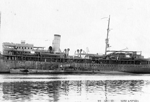 | 1.30k | Beaver (AS-5) in port, circa 1919, with R-20 (SS-97) & R-17 (SS-94) along side. | Photo i.d. courtesy of Ric Hedman. USNHC photograph # NH 56364 via Robert Hurst. |
|
 | 63k | R-20 (SS-97) with the R-16 (SS-93) in the background taken from the deck of the R-14 (SS-91) off the shores of Hawaii circa 1920's. | Photo courtesy of Ric Hedman. | |
 |
412k | Subs R U.S. From right to left: R-16 (SS-93), R-18 (SS-95), R-19 (SS-96), R-12 (SS-89), R-13 (SS-90), R-11 (SS-88), R-17 (SS-94), R-20 (SS-97), R-14 (SS-91) & R-15 (SS-92) | Photo courtesy of David Wright. | |
 |
516k | Union Iron Works R Class Boats - deck gun images in Pearl Harbor. This photo shows major work to add sponsons and deck for larger gun decks; left to right R-19 (SS-96), R-18 (SS-95), R-15 (SS-92), R-17 (SS-94) & R-20 (SS-97). This photo from left to right shows R-18, R-15, R-17 & R-20 from a different angle than first photo (not in focus). The dark area in the middle of the gun deck is either the disappeared 3’/23 gun or base for the 3”/50.? Note: Monterey (M-6) is in the background, left of the large crane. She was station ship at Pearl Harbor from 12/19/1917 to 8/27/1921. |
Photos from the files of the Vallejo Naval & Historical Museum via Darryl L. Baker. | |
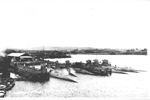 |
1.53k | R-boats at Pearl Harbor, circa early 1920's. From L-R: R-18 (SS-95), R-16 (SS-93), R-20 (SS-97), R-17 (SS-94), R-15 (SS-92), R-19 (SS-96). |
Photo courtesy of Ric Hedman. | |
 0808108 | 1.22k | Submarines (middle) R-4 (SS-81) & (right) R-20 (SS-97) along side municipal pier, San Diego, Cal. | Photo courtesy of digitalcommonwealth.org | |
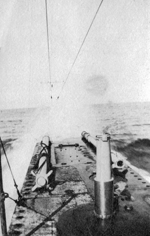 |
1.08k | 4 page PDF of a what is probably the R-20 (SS-97). Bow-1 shows the Y Tube hydrophone, stowed mast and the short barrel of the 3/23 gun (retracted). Bow-2 is a better view of the 3/23 barrel. Note: I don’t see the recoil cylinder above the gun shield (hatch cover). Next two photos: X Class Stern-1 & 2 – view of the stern of the boat and another boat following astern. |
Photos from the files of the Vallejo Naval & Historical Museum via Darryl L. Baker. | |
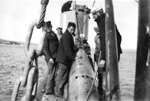 |
737k | 9 page PDF of a sequence of R-20 (SS-97). The first two are of the Los Angeles Lighthouse which at the entrance of the San Pedro/Long Beach/Los Angeles Harbor. Photo of Point Loma and entrance buoy “3SD” to San Diego Harbor. Note: This buoy is listed in 1923 chart book of San Diego Harbor and is describe as “Black, conical skeleton super structure” & three photos of torpedo handling aboard R-20. You can see one of R-20's strips on her fairwater in photo “Pg 5 R-20 Torp Loading-3”. The last photo – 2 R Class boats and a sub chaser. |
Photos from the files of the Vallejo Naval & Historical Museum via Darryl L. Baker. | |
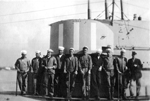 |
461k | 4 page PDF of the R-20 (SS-97). 1st photo - Looking through other photos and have determined that bridge shape shown only lasted a short period of time. Plus the placement of the stripes will be changed as well. This photo from PigBoats show confirmation of stripes location at an early point in her history and lack of deck gun on her and sister boats. Photo at Pearl. Also note that all boats have their torpedo loading masts and booms secured to the fore deck as seen in one earlier photo sequence. 2nd photo - Photo with 3"/23; Probably a photo of the gun crew. Noticing the lack of recoil tube above or below the barrel. Seems to be an awning over the bridge but a hint of the radio antennae spreaders just above it. R-20 was built at Union Iron Works in San Francisco and may have had this gun for a short time while waiting for a larger gun. If so we have a bit of unknown sub history being made known for the first time. Seems odd due to the amount of structural changes needed to place and remove this gun. One of the two main reasons for the disappearing mount was to protect the breech end of the gun from water and sea spray. It would make no sense to leave it up for even a moderate run. The amount of maintenance necessary afterwards would make any time saved irrelevant. The breech end and the liner of the gun was not designed to be dunked in salt water. Thus, one of the two reasons for the retraction into the tub. The circular gun shield doubled as the watertight hatch for the tub, with only a portion of the recoil cylinder and the muzzle end of the gun poking through. The muzzle would have had a tampion inserted before the dive. It wouldn’t surprise me if the seal around the tub leaked occasionally so it is safe to assume that the bottom of the tub had a drain valve. Obviously the 2nd major reason for this unusual gun was drag reduction, which it did quite well when compared to other guns, and it was probably the only thing about the gun that was a positive feature. The gun was underpowered with too short of a range, and its shells lacked enough punch to finish off targets quickly. The mount reportedly also had the unnerving tendency to retract into the tub when it was fired, with obvious potential negative impacts on the gun’s crew. The huge tub that protruded down into the forward battery was also disliked due to the amount of room it used up. All in all the gun was a failure with the 4”/50 caliber Mk 9 that followed it being highly respected and liked. 3rd photo - The radio antennae spreaders and location of the handholds on the side of the conn match with the side view of the conn along with the large square scupper for draining the bridge. Last photo - The man is married, (note wedding band on left hand). He is a 1st Class Electrician (radioman badge on lower left arm) with between 8 and 12 years of service. Photo taken before 3 stripes are painted on Conn. Nice shot of Bell location. |
Partial text via Ric Hednan. Gun text via David Johnston (USN, retired) Photos from the files of the Vallejo Naval & Historical Museum via Darryl L. Baker. |
|
 |
549k | 5 page PDF of a sequence of five photos of a submarine plowing through the sea and following two other submarines and with a sub chaser to the port. Not sure of the photo sequence since we are talking an old camera and it would take a few seconds to advance the film. I believe this is the R-20 (SS-97). | Photos from the files of the Vallejo Naval & Historical Museum via Darryl L. Baker. | |
 |
516k | 6 photo PDF showing internal views of the R-20 (SS-97): Photo #1:Main switch board. Photo #4:Trim and drain manifold in the control room. Photo #5: Air manifold in the control room, with the Kingston valve levers on the right. Notice the Lewis gun mounted above, along with what appears to be a BAR. |
Photo i.d. via David Johnston (USN, retired) Photos from the files of the Vallejo Naval & Historical Museum via Darryl L. Baker. |
|
 |
2.10k | 4 photo PDF showing internal views of the R-20 (SS-97): Photo #3:This photo is of the after battery looking forward into the control room. Notice the crewman is sitting on the stand for the third periscope that these boats temporarily installed in the after battery. These periscopes didn’t last long and were removed in just a few years. Photo #4:This photo shows the "Gun Locker" on the right with what looks like 6 1903 Springfield Rifles. They seem to be stored one barrel up next barrel down alternating to save space. With the amount of lockers visible this must be crews berthing. The large rod in the left overhead is the drive rod for the bow planes. Note the "+" over the door. Perhaps it is meant to call attention to the medical kit above it. |
Photo i.d. via Dave Johnston & Ric Hednan. Photos from the files of the Vallejo Naval & Historical Museum via Darryl L. Baker. |
|
 | 123k | R-20 (SS-97) possibly in the Thames River near New London CT., between April - June 1941. | Text courtesy of DANFS. USN photo courtesy of ussubvetsofwwii.org. |
|
 |
1.36k | R-20 (SS-97) in Pearl Harbor circa 1924/25. My Great Grandfather was a Major in the 13th Field Artillery and had some sort of involvement in the tactical development of submarine warfare taking place with the R-Classes while assigned to Schofield Barracks under the Hawaiian Division. There is a picture of him on the submarine (Major Ralph Hospital). |
Photo courtesy of Brendan B. Finnegan. | |
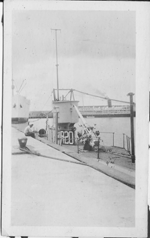 |
2.17k | R-20 (SS-97) in Pearl Harbor circa 1924/25. | Photo courtesy of Brendan B. Finnegan. | |
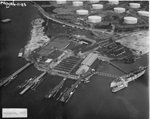 | 3.08k | R & S boats at the sub base, Pearl Harbor, November 1925. The barracks ship, ex-Chicago (CL-14) is at the right of the photo. | Photo from the private collection of Ric Hedman. | |
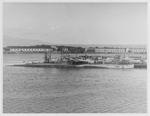 |
776k | Four submarines docked at Pearl Harbor, circa summer 1927: foreground is the S-16 (SS-121), R-3 (SS-80), R-4 (SS-81) & at the right background, is another submarine with 3 vertical stripes, the R-20 (SS-97). | Photo & text i.d. courtesy of Ric Hedman. Photo by Bettmann / Getty Images, courtesy of gettyimages.com. |
|
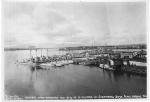 | 292k | The crews of Submarine Divisions 9 & 14 line the decks of their boats (20 in all) at the Submarine base at Pearl Harbor on 12 December 1930. R-1 (SS-78), R-2 (SS-79), R-3 (SS-80), R-4 (SS-81), R-5 (SS-82), R-6 (SS-83), R-7 (SS-84), R-8 (SS-85), R-9 (SS-86), R-10 (SS-87), R-11 (SS-88), R-12 (SS-89), R-13 (SS-90), R-14 (SS-91), R-15 (SS-92), R-16 (SS-93), R-17 (SS-94), R-18 (SS-95), R-19 (SS-96) & R-20 (SS-97). All the R-boats were to leave the base where they had been serving for upwards of 8 years and transfer to the East coast to be decommissioned over the next 3 years. The only identifiable boat is the R-16. | USN photo by Tai Sing Loo, courtesy of E. Little. | |
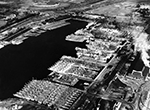 |
2.49k | Philadelphia Navy Yard, 28 October 1940. The photo presented panorama military shipyards in Philadelphia Navy Yard. Most of the ships are obsolete US destroyers, that were transfer to Great Britain under lend lease. The submarines are on the left hand side of the photo, and they are: (in no particular order) The O boats:O-1 (SS-62), O-2 (SS-63), O-3 (SS-64), O-6 (SS-67), O-7 (SS-68), O-8 (SS-69), O-9 (SS-70), O-10 (SS-71). The R boats: R-1 (SS-78), R-2 (SS-79), R-3 (SS-80), R-5 (SS-82), R-6 (SS-83), R-7 (SS-84), R-8 (SS-85), R-9 (SS-86), R-10 (SS-87), R-12 (SS-89), R-15 (SS-92), R-16 (SS-93), R-17 (SS-94), R-18 (SS-95), R-19 (SS-96) & R-20 (SS-97). The S boats: S-11 (SS-116), S-12 (SS-117), S-13 (SS-118), S-14 (SS-119), S-15 (SS-120), S-16 (SS-121), S-17 (SS-122) & S-48 (SS-159). The Olympia (C-6) is shown at the right of the wharf on Broad Street. The stadium in the upper left, was John F. Kennedy Stadium (formally Philadelphia Municipal Stadium)that stood from 1926 to 1992. It was erected for the 1926 Sesquicentennial. |
Photo i.d. courtesy of Ron Reeves (of blessed memory). Photo courtesy of flickr.com. Lower resolution photo. (548k) |
|
 |
417k | These World War submarines, [O & R-boats] tied up in the Navy Yard in Philadelphia for a dozen years, are being reconditioned and some are already in active service again, it was announced 10 January 1941. This picture shows them as they appeared before the repair program began. From Left to right: O-3 (SS-64), unknown, R-1 (SS-78), R-7 (SS-84), R-20 (SS-97), R-19 (SS-96) & R-17 (SS-94). | Photo courtesy of the George D. McDowell Philadelphia Evening Bulletin Photographs @ digital.library.temple.edu | |
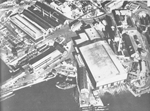 |
401k | This air view of Portsmouth Navy Yard taken just after the end of WW II shows the main shipbuilding shed which enabled construction to continue unimpeded by the Maine winters. The shed was widened to add two ways in 1941, and a fifth was squeezed in a year later. Drydocks No. 1 (left) & 2 (far right) contain six fleet submarines, while three R-boats are moored in the foreground. The Pompano (SS-491) would have been under construction in the first ways on the left hand corner of the main shipbuilding shed. |
Photo and partial text from The Fleet Submarine in the U.S. Navy: A Design and Construction History, by John D. Alden. | |
| Back To The Main Photo Index | Back To the Submarine Index |
|
Problems and site related matters, E-mail Webmaster |
|
This page is created by Gary Priolo and maintained by Michael Mohl All Pages © 1996 - 2025 NavSource History |